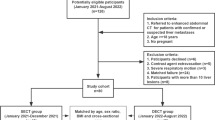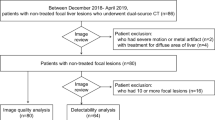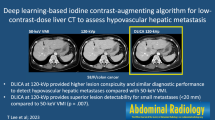Abstract
Objectives
To compare the image quality and hepatic metastasis detection of low-dose deep learning image reconstruction (DLIR) with full-dose filtered back projection (FBP)/iterative reconstruction (IR).
Methods
A contrast-detail phantom consisting of low-contrast objects was scanned at five CT dose index levels (10, 6, 3, 2, and 1 mGy). A total of 154 participants with 305 hepatic lesions who underwent abdominal CT were enrolled in a prospective non-inferiority trial with a three-arm design based on phantom results. Data sets with full dosage (13.6 mGy) and low dosages (9.5, 6.8, or 4.1 mGy) were acquired from two consecutive portal venous acquisitions, respectively. All images were reconstructed with FBP (reference), IR (control), and DLIR (test). Eleven readers evaluated phantom data sets for object detectability using a two-alternative forced-choice approach. Non-inferiority analyses were performed to interpret the differences in image quality and metastasis detection of low-dose DLIR relative to full-dose FBP/IR.
Results
The phantom experiment showed the dose reduction potential from DLIR was up to 57% based on the reference FBP dose index. Radiation decreases of 30% and 50% resulted in non-inferior image quality and hepatic metastasis detection with DLIR compared to full-dose FBP/IR. Radiation reduction of 70% by DLIR performed inferiorly in detecting small metastases (< 1 cm) compared to full-dose FBP (difference: −0.112; 95% confidence interval [CI]: −0.178 to 0.047) and full-dose IR (difference: −0.123; 95% CI: −0.182 to 0.053) (p < 0.001).
Conclusion
DLIR enables a 50% dose reduction for detecting low-contrast hepatic metastases while maintaining comparable image quality to full-dose FBP and IR.
Key Points
• Non-inferiority study showed that deep learning image reconstruction (DLIR) can reduce the dose to oncological patients with low-contrast lesions without compromising the diagnostic information.
• Radiation dose levels for DLIR can be reduced to 50% of full-dose FBP and IR for detecting low-contrast hepatic metastases, while maintaining comparable image quality.
• The reduction of radiation by 70% by DLIR is clinically acceptable but insufficient for detecting small low-contrast hepatic metastases (< 1 cm).






Similar content being viewed by others
Abbreviations
- 2AFC:
-
Two-alternative forced choice
- CI:
-
Confidence interval
- CNR:
-
Contrast-to-noise ratio
- CT:
-
Computed tomography
- CTDIvol :
-
Volumetric CT dose index
- DLIR:
-
Deep learning image reconstruction
- FBP:
-
Filtered back projection
- FOM:
-
Figure of merit
- GEE:
-
Generalized estimating equations
- IQR:
-
Interquartile range
- IR:
-
Iterative reconstruction
- JAFROC:
-
Jackknife alternative free-response receiver operating characteristic
References
Geyer LL, Schoepf UJ, Meinel FG et al (2015) State of the art: iterative CT reconstruction techniques. Radiology 276:339–357
Mileto A, Guimaraes LS, McCollough CH, Fletcher JG, Yu L (2019) State of the art in abdominal CT: the limits of iterative reconstruction algorithms. Radiology 293:491–503
Solomon J, Lyu P, Marin D, Samei E (2020) Noise and spatial resolution properties of a commercially available deep learning-based CT reconstruction algorithm. Med Phys 47:3961–3971
Chen B, Christianson O, Wilson JM, Samei E (2014) Assessment of volumetric noise and resolution performance for linear and nonlinear CT reconstruction methods. Med Phys 41:071909
Nagayama Y, Sakabe D, Goto M et al (2021) Deep learning-based reconstruction for lower-dose pediatric CT: technical principles, image characteristics, and clinical implementations. Radiographics 41:1936–1953
Fletcher JG, Fidler JL, Venkatesh SK et al (2018) Observer performance with varying radiation dose and reconstruction methods for detection of hepatic metastases. Radiology 289:455–464
McCollough CH, Yu L, Kofler JM et al (2015) Degradation of CT low-contrast spatial resolution due to the use of iterative reconstruction and reduced dose levels. Radiology 276:499–506
Choi H, Chang W, Kim JH et al (2022) Dose reduction potential of vendor-agnostic deep learning model in comparison with deep learning-based image reconstruction algorithm on CT: a phantom study. Eur Radiol 32:1247–1255
Racine D, Brat HG, Dufour B et al (2021) Image texture, low contrast liver lesion detectability and impact on dose: deep learning algorithm compared to partial model-based iterative reconstruction. Eur J Radiol 141:109808
Greffier J, Hamard A, Pereira F et al (2020) Image quality and dose reduction opportunity of deep learning image reconstruction algorithm for CT: a phantom study. Eur Radiol 30:3951–3959
Hsieh J, Liu E, Nett B, Tang J, Thibault J-B, Sahney S (2019) A new era of image reconstruction: TrueFidelity™. White Paper (JB68676XX), GE Healthcare
Bornet PA, Villani N, Gillet R et al (2022) Clinical acceptance of deep learning reconstruction for abdominal CT imaging: objective and subjective image quality and low-contrast detectability assessment. Eur Radiol 32:3161–3172
Fletcher JG, Yu L, Fidler JL et al (2017) Estimation of observer performance for reduced radiation dose levels in CT: eliminating reduced dose levels that are too low is the first step. Acad Radiol 24:876–890
Jensen CT, Gupta S, Saleh MM et al (2022) Reduced-dose deep learning reconstruction for abdominal CT of liver metastases. Radiology 303:90–98
Noda Y, Kaga T, Kawai N et al (2021) Low-dose whole-body CT using deep learning image reconstruction: image quality and lesion detection. Br J Radiol :20201329
Solomon J, Mileto A, Ramirez-Giraldo JC, Samei E (2015) Diagnostic performance of an advanced modeled iterative reconstruction algorithm for low-contrast detectability with a third-generation dual-source multidetector CT scanner: potential for radiation dose reduction in a multireader study. Radiology 275:735–745
Jensen CT, Liu X, Tamm EP et al (2020) Image quality assessment of abdominal CT by use of new deep learning image reconstruction: initial experience. AJR Am J Roentgenol 215:50–57
Solomon J, Marin D, Roy Choudhury K, Patel B, Samei E (2017) Effect of radiation dose reduction and reconstruction algorithm on image noise, contrast, resolution, and detectability of subtle hypoattenuating liver lesions at multidetector CT: filtered back projection versus a commercial model-based iterative reconstruction algorithm. Radiology 284:777–787
Kanal KM, Butler PF, Sengupta D, Bhargavan-Chatfield M, Coombs LP, Morin RL (2017) U.S. diagnostic reference levels and achievable doses for 10 adult CT examinations. Radiology 284:120–133
Lv P, Zhou Z, Liu J et al (2019) Can virtual monochromatic images from dual-energy CT replace low-kVp images for abdominal contrast-enhanced CT in small- and medium-sized patients. Eur Radiol 29:2878–2889
Lee KH, Lee JM, Moon SK et al (2012) Attenuation-based automatic tube voltage selection and tube current modulation for dose reduction at contrast-enhanced liver CT. Radiology 265:437–447
Bellini D, Ramirez-Giraldo JC, Bibbey A et al (2017) Dual-source single-energy multidetector CT used to obtain multiple radiation exposure levels within the same patient: phantom development and clinical validation. Radiology 283:526–537
Boone JMSK, Cody DD, McCollough CH, McNitt-Gray MF, Toth TL (2011) Size-specific dose estimates (SSDE) in pediatric and adult body CT examinations. In: Report of Am Assoc Phys Med AAPM Task Group 204. American Association of Physicists in Medicine, College Park
Nam JG, Hong JH, Kim DS, Oh J, Goo JM (2021) Deep learning reconstruction for contrast-enhanced CT of the upper abdomen: similar image quality with lower radiation dose in direct comparison with iterative reconstruction. Eur Radiol 31:5533–5543
Park S, Yoon JH, Joo I et al (2022) Image quality in liver CT: low-dose deep learning vs standard-dose model-based iterative reconstructions. Eur Radiol 32:2865–2874
Lyu P, Neely B, Solomon J et al (2021) Effect of deep learning image reconstruction in the prediction of resectability of pancreatic cancer: diagnostic performance and reader confidence. Eur J Radiol 141:109825
Racine D, Becce F, Viry A et al (2020) Task-based characterization of a deep learning image reconstruction and comparison with filtered back-projection and a partial model-based iterative reconstruction in abdominal CT: a phantom study. Phys Med 76:28–37
Nakamura Y, Narita K, Higaki T, Akagi M, Honda Y, Awai K (2021) Diagnostic value of deep learning reconstruction for radiation dose reduction at abdominal ultra-high-resolution CT. Eur Radiol 31:4700–4709
Wang X, Zheng F, Xiao R et al (2021) Comparison of image quality and lesion diagnosis in abdominopelvic unenhanced CT between reduced-dose CT using deep learning post-processing and standard-dose CT using iterative reconstruction: a prospective study. Eur J Radiol 139:109735
Acknowledgements
We are grateful to Dr. Scott Robertson, Dr. Joshua Wilson, Nicole Lafata, Dr. Crystal Green, Dr. Steve Mann and Dr. Jeffrey Ashton from Duke University Medical Center for completing the 2AFC experiment of this work. We also thank Brian Thomsen, a senior research manager from GE Healthcare in USA, for providing technical consultation in this study.
Funding
Dr. Peijie Lyu received funding as research fellowship scholarship from GE Healthcare between 2019 to 2020, and received financial support from Key Scientific Research Project of Higher Education in Henan Province (22A320057).
Author information
Authors and Affiliations
Corresponding author
Ethics declarations
Guarantor
The scientific guarantor of this publication is Dr. Jianbo Gao.
Conflict of interest
The authors of this manuscript declare relationships with the following companies: GE Healthcare China for Luotong Wang. The other authors declare that they have no conflict of interest.
Statistics and biometry
One of the authors has significant statistical expertise.
Informed consent
The institutional review board approved this single-institution prospective study (Registry number: ChiCTR-DPD-16010302), and all participants provided written informed consent before enrollment.
Ethical approval
Institutional Review Board approval was obtained.
Methodology
• prospective
• diagnostic study
• performed at two institutions (phantom part performed in Duke University Medical Center, clinical part performed in The First Affiliated Hospital of Zhengzhou University)
Additional information
Publisher’s note
Springer Nature remains neutral with regard to jurisdictional claims in published maps and institutional affiliations.
Supplementary information
ESM 1
(DOCX 1289 kb)
Rights and permissions
Springer Nature or its licensor (e.g. a society or other partner) holds exclusive rights to this article under a publishing agreement with the author(s) or other rightsholder(s); author self-archiving of the accepted manuscript version of this article is solely governed by the terms of such publishing agreement and applicable law.
About this article
Cite this article
Lyu, P., Liu, N., Harrawood, B. et al. Is it possible to use low-dose deep learning reconstruction for the detection of liver metastases on CT routinely?. Eur Radiol 33, 1629–1640 (2023). https://doi.org/10.1007/s00330-022-09206-3
Received:
Revised:
Accepted:
Published:
Issue Date:
DOI: https://doi.org/10.1007/s00330-022-09206-3




